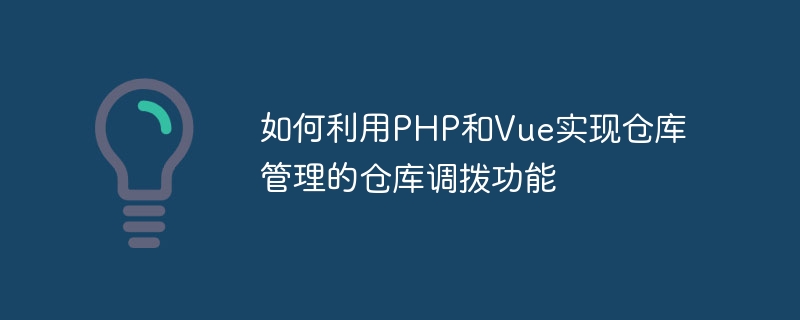

How to use PHP and Vue to implement the warehouse allocation function of warehouse management
In modern logistics management, warehouse allocation is a common operation, which involves moving goods Transfers from one warehouse to another are aimed at optimizing inventory and meeting demand in different regions. This article will introduce how to use PHP and Vue to implement the warehouse allocation function in the warehouse management system, and give specific code examples.
First of all, we need to build a basic warehouse management system. In this system, we will include the following key components: warehouse management background, transfer list, and transfer form.
<?php
// 连接数据库
$conn = new mysqli("localhost", "username", "password", "dbname");
// 获取仓库列表
$sql = "SELECT * FROM warehouses";
$result = $conn->query($sql);
// 输出仓库列表
if ($result->num_rows > 0) {
while($row = $result->fetch_assoc()) {
echo "仓库名称:" . $row["name"]. "<br>";
echo "仓库地址:" . $row["address"]. "<br><br>";
}
} else {
echo "暂无仓库信息";
}
// 关闭数据库连接
$conn->close();
?>The following is a simple Vue code example to display the transfer list:
<template>
<div>
<h1>调拨列表</h1>
<table>
<thead>
<tr>
<th>调出仓库</th>
<th>调入仓库</th>
<th>调拨数量</th>
</tr>
</thead>
<tbody>
<tr v-for="transfer in transfers" :key="transfer.id">
<td>{{ transfer.fromWarehouse }}</td>
<td>{{ transfer.toWarehouse }}</td>
<td>{{ transfer.quantity }}</td>
</tr>
</tbody>
</table>
</div>
</template>
<script>
export default {
data() {
return {
transfers: [
{ id: 1, fromWarehouse: '仓库A', toWarehouse: '仓库B', quantity: 10 },
{ id: 2, fromWarehouse: '仓库B', toWarehouse: '仓库C', quantity: 5 },
],
};
},
};
</script>The following is a simple Vue code example for implementing the allocation form:
<template>
<div>
<h1>新调拨</h1>
<form @submit.prevent="submitForm">
<label for="fromWarehouse">调出仓库:</label>
<select id="fromWarehouse" v-model="fromWarehouse">
<option value="仓库A">仓库A</option>
<option value="仓库B">仓库B</option>
<option value="仓库C">仓库C</option>
</select><br>
<label for="toWarehouse">调入仓库:</label>
<select id="toWarehouse" v-model="toWarehouse">
<option value="仓库A">仓库A</option>
<option value="仓库B">仓库B</option>
<option value="仓库C">仓库C</option>
</select><br>
<label for="quantity">调拨数量:</label>
<input type="number" id="quantity" v-model="quantity"><br><br>
<button type="submit">提交</button>
</form>
</div>
</template>
<script>
export default {
data() {
return {
fromWarehouse: '',
toWarehouse: '',
quantity: 0,
};
},
methods: {
submitForm() {
// 在这里可以将表单数据通过Ajax请求发送到服务器,完成调拨操作
console.log(this.fromWarehouse, this.toWarehouse, this.quantity);
},
},
};
</script>Through the above code example, we can see the warehouse allocation function in the basic warehouse management system How to implement it using PHP and Vue. The warehouse management background is responsible for managing warehouse information. The transfer list displays the transfer records that have been carried out, and the transfer form is used to perform new transfer operations. Of course, in practical applications, we also need to perform legality checks, permission verification, etc. on data to ensure the security and stability of the system.
I hope this article can help you understand how to use PHP and Vue to implement the warehouse allocation function in the warehouse management system, and gives specific code examples so that you can better apply it to actual projects. If you have any questions, please leave a message for discussion.
The above is the detailed content of How to use PHP and Vue to implement the warehouse allocation function of warehouse management. For more information, please follow other related articles on the PHP Chinese website!